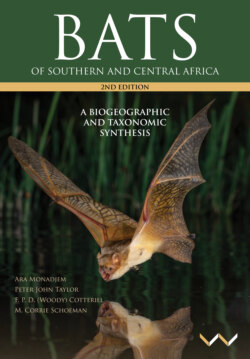Читать книгу Bats of Southern and Central Africa - Ara Monadjem - Страница 58
На сайте Литреса книга снята с продажи.
ОглавлениеEpomophorus dobsonii Bocage 1889
Dobson’s epauletted fruit bat Least Concern
Description: Epomophorus dobsonii is a large bat with a mass over 100 g in adult males. The pelage is greyish-brown. The wings are dark brown. Adult males are larger than females, and may be distinguished by a broader muzzle with a folded upper lip and the presence of shoulder epaulettes. These epaulettes are pockets containing long (18 mm in length) white fur that can be erected to display prominent white shoulder patches. At rest, these patches disappear as the fur is retracted into the pocket. Adult males also have dark grey-brown throats, while females have greyish throats. The ears have a patch of white fur at their base. The muzzle is dog-like and broader than that of most similar-sized Epomophorus species.
The skull is robust with sturdy zygomatic arches. In lateral profile, the rostrum and interorbital region are rather flat, while the parietal region is deflected downwards. From above, the rostrum is broad. There are five thick palatal ridges present, two beyond the last molar. The first three ridges are continuous while the last two are divided, giving the impression of four triangles behind the last molar. The dental formula is 2121/2132 = 28.
Key identification features: The combination of white patches at the base of the ears and shoulder epaulettes (males) separates Epomops and Epomophorus from other large fruit bats. Palatal ridges immediately separate these two genera, with Epomophorus exhibiting six narrow ridges (five thick ridges in E. dobsonii). Epomophorus dobsonii is easily distinguished from E. franqueti by the number of post-dental palatal ridges (two in E. dobsonii, five in E. franqueti).
Echolocation call: This bat does not echolocate.
Distribution, habitat and roosting: Epomophorus dobsonii is widespread in the northern parts of the region, where it has been recorded from central Angola and northern Botswana (Smithers 1971), east through Zambia, southern DRC and northern Malawi. It may have been overlooked over much of eastern Angola, the Caprivi Strip of Namibia, and the extreme northwest of Mozambique. The type specimen is from Quindumbo, Angola. This specimen (housed in the Museu Bocage) was destroyed in the tragic fire of 1978. Bergmans (1989) selected a new type specimen from Chitau approximately 250 km to the southwest of Quindumbo (AMNH 88068, Neotype).
This species is poorly represented in museums, with only 27 records examined for this book.
| External and cranial measurements (mm) and mass (g) for Epomophorus dobsonii, males and females presented separately | |||||||||||
|---|---|---|---|---|---|---|---|---|---|---|---|
| Mean | Min | Max | SD | N | Mean | Min | Max | SD | N | ||
| Males | Females | ||||||||||
| Mass 1, 4 | 124.5 1 | 20.0 | 129.0 | - | 2 | Mass | - | - | - | - | - |
| FA 2 | 86.9 | 84.0 | 89.9 | - | 11 | FA 2 | 83.7 | 80.4 | 88.3 | - | 11 |
| Total 3 | 160.0 | 146 | 168 | - | 4 | Total 3 | 142.0 | 137 | 145 | - | 3 |
| Tail | - | - | - | - | - | Tail | - | - | - | - | - |
| Tibia | - | - | - | - | - | Tibia | - | - | - | - | - |
| Ear 1 | 30 | - | - | - | 1 | Ear 1 | 26 | 25 | 27 | - | 3 |
| CI 4 | 51.8 | - | - | - | 1 | CI 4 | 47.5 | - | - | - | 1 |
1 Smithers (1971)2 Extracted from Bergmans (1989) using data from Angola, Malawi and Zambia3 Skinner and Chimimba (2005)4 Specimens measured by the authors
A single specimen was collected amidst a colony of Epomophorus crypturus hanging in a riparian tree (Smithers 1971). Epomophorus dobsonii is associated with miombo woodland throughout Angola and Zambia, although the single specimen from Botswana was collected in riverine woodland (Smithers 1971).
Extralimital: The core of this species’ distributional range is in southern Africa, beyond which it occurs in a narrow band through Tanzania to Rwanda (Bergmans 1989).
Foraging ecology: There is no information on the diet or foraging behaviour of this species.
Reproduction: In Zambia, immature individuals have been collected in September and November (Bergmans 1989).
Figure 53. Skull and teeth of Epomophorus dobsonii: (a) dorsal view, (b) ventral view, (c) lateral view, and (d) lateral view of mandible (DM 14437).
Figure 54. Epomophorus dobsonii, portrait showing white ear tufts (© F. P. D. Cotterill).
SYSTEMATIC NOTES
1889.Epomophorus dobsonii Bocage, Jornal de sciencias mathematicas, physicas e naturaes, Lisboa (2)1: 1. Quindumbo, Benguela district, western Angola.
Epomophorus dobsonii was previously placed in Epomops but is atypical of that genus (Bergmans 1989), as it has only two post-dental palatal ridges; the other two Epomops species, E. franqueti and E. buettikoferi, both have five such ridges. Recent molecular studies have demonstrated that it is more closely allied to Epomophorus than Epomops (Almeida et al. 2016).
1 Smithers (1971)
2 Extracted from Bergmans (1989) using data from Angola, Malawi and Zambia
3 Skinner and Chimimba (2005)
4 Specimens measured by the authors
